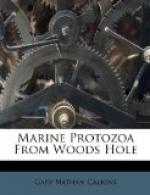Frontonia leucas Ehr. Fig. 37.
Synonyms: Frontonia vernalis Ehr. ’38; Bursaria leucas Allman ’55, Carter ’56; Panophrys leucas Duj. ’41, Stein ’67; Panophrys vernalis Dujardin ’41, Stein ’67; P. chrysalis Duj. ’41, Fromentel ’74; Cyrtostomum leucas Stein ’67, Kent ’81.
Form ovoid, elongate, occasionally a little flattened dorso-ventrally. Mouth in the anterior third of the body. The left edge of the mouth carries a distinct undulating membrane; the right edge is plain, longitudinally striated and bears cilia. It is slightly depressed and the depression is carried posteriorly in the form of a shallow furrow which reaches to the posterior end. The contractile vacuole is on the left side, the spheroidal nucleus on the right side of the furrow. The body is uniformly covered with fine cilia, and the periphery is uniformly studded with large trichocysts, except along the furrow. Food consists of dinoflagellates and other small forms. Color dark brown to black.
Length 330 mu; width 200 mu.
This form differs considerably from the fresh-water Frontonia leucas as described by Schewiakoff ’89, especially in the extreme length of the peristomial furrow, in the position of the nucleus and contractile vacuole, and in the nature of the water canals. These in the Woods Hole form are very irregular in size and very much branched, not uniform as in Lieberkuehn’s (see Buetschli) figure of Frontonia leucas, nor radiating as in Schewiakoff’s description. This may be the same species as Frontonia marina, of Fabre-Domergue ’91, whose description and figure I have not seen.
[Illustration: Fig. 37.—Frontonia Leucas.]
Genus COLPIDIUM Stein ’60
(Buetschli ’88; Maupas ’83.)
The general form is oval, slightly compressed laterally with the dorsal side strongly arched. The ventral side is slightly incurved. The anterior end is somewhat smaller than the posterior end, which is broadly rounded. The mouth is placed some distance from the anterior end in an oral depression and opens into a tubular oesophagus. There are usually two undulating membranes which do not extend beyond the mouth borders. The right undulating membrane extends down into the oesophagus and appears to be attached to the walls of the latter. The body stripes in front of the mouth are twisted to the left. The anus is terminal and the contractile vacuole may be terminal or situated forwards in the dorsal region. The macronucleus is spherical and has one micronucleus attached. Food consists mainly of bacteria. Movement rapid, but interrupted.




